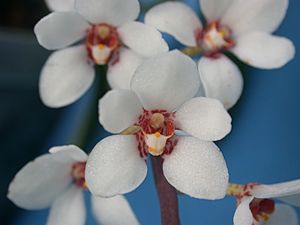Large boulder orchid facts for kids
Quick facts for kids Large boulder orchid |
|
|---|---|
 |
|
| Conservation status | |
| Scientific classification | |
| Genus: |
Sarcochilus
|
| Species: |
hartmannii
|
| Synonyms | |
The Large Boulder Orchid (scientific name: Sarcochilus hartmannii) is a special type of orchid. It's also known as the ravine orchid or cliff orchid. This plant grows naturally only in eastern Australia. It often forms large groups, usually on rocks. It has thick leaves and beautiful white flowers with red spots.
Contents
What Does the Large Boulder Orchid Look Like?
The Large Boulder Orchid is a herbaceous plant, which means it has soft stems, not woody ones. It usually grows on rocks, but sometimes it can grow on trees or even in the ground. Its stems can be between 200 and 800 millimeters (about 8 to 31 inches) long.
Leaves and Stems
This orchid forms spreading clumps. It has about four to ten thick leaves. These leaves are long and narrow, like a line or a triangle. They can be 80 to 200 millimeters (about 3 to 8 inches) long. The leaves are also about 15 to 20 millimeters (about 0.6 to 0.8 inches) wide.
Flowers and Blooming Season
The Large Boulder Orchid produces many flowers. You can find between five and twenty-five white flowers on one plant. Each flower has crimson (dark red) spots near its center. The flowers are about 25 to 30 millimeters (about 1 to 1.2 inches) long and wide. They grow on an arching stem that is 100 to 250 millimeters (about 4 to 10 inches) long.
The parts of the flower include:
- Sepals: These are like small leaves that protect the flower bud. They are 12 to 16 millimeters (about 0.5 to 0.6 inches) long.
- Petals: These are the colorful parts of the flower. They are 10 to 14 millimeters (about 0.4 to 0.5 inches) long.
- Labellum: This is a special lip-shaped petal. It is thick and waxy, about 2 to 3 millimeters (about 0.08 to 0.12 inches) long. It has three parts, called lobes. The side lobes stand up, and the middle lobe is short and fleshy.
This orchid usually blooms between September and November.
How the Large Boulder Orchid Got Its Name
The Sarcochilus hartmannii was first officially described in 1874. A scientist named Ferdinand von Mueller wrote about it. He published his description in a book called Fragmenta phytographiae Australiae.
Honoring the Collector
The plant was found near Toowoomba by Carl Heinrich Hartmann. The second part of its scientific name, hartmannii, was chosen to honor him. This is a common way to name new species, by using the name of the person who discovered them.
Where Does the Large Boulder Orchid Live?
The Large Boulder Orchid mostly grows on large rocks and cliffs. Sometimes, it can also be found on trees or cycads (a type of ancient plant).
Geographic Range
You can find this orchid in eastern Australia. Its range stretches from Gympie in south-east Queensland down to the Richmond River in New South Wales.
Protecting the Large Boulder Orchid
The Large Boulder Orchid is considered "vulnerable." This means it's at risk of becoming endangered if we don't protect it.
Conservation Status
Both the Australian Government and the New South Wales Government have laws to protect this orchid.
- The Australian Government lists it as vulnerable under the Environment Protection and Biodiversity Conservation Act 1999.
- The New South Wales Government also lists it as vulnerable under the Biodiversity Conservation Act 2016.
Threats to the Orchid
The main dangers to the Large Boulder Orchid are:
- Illegal collecting: Some people try to take these orchids from their natural homes, which is against the law.
- Weed invasion: Weeds can grow around the orchids and compete for space, water, and sunlight.
Protecting these plants helps keep our natural environment healthy and diverse.


